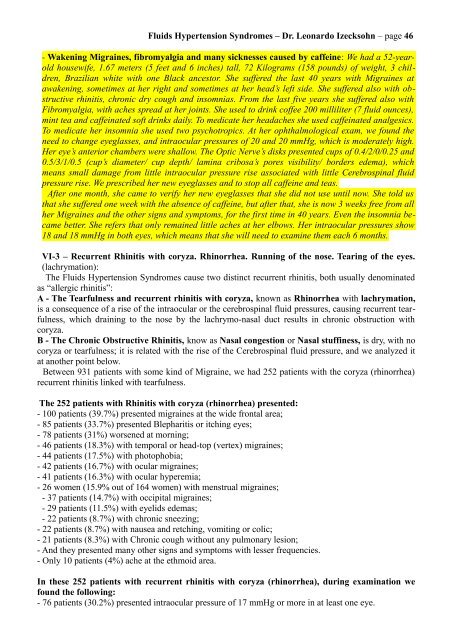Fluids Hypertension Syndromes: Migraines, Headaches, Normal ...
Fluids Hypertension Syndromes: Migraines, Headaches, Normal ...
Fluids Hypertension Syndromes: Migraines, Headaches, Normal ...
Create successful ePaper yourself
Turn your PDF publications into a flip-book with our unique Google optimized e-Paper software.
<strong>Fluids</strong> <strong>Hypertension</strong> <strong>Syndromes</strong> – Dr. Leonardo Izecksohn – page 46<br />
- Wakening <strong>Migraines</strong>, fibromyalgia and many sicknesses caused by caffeine: We had a 52-yearold<br />
housewife, 1.67 meters (5 feet and 6 inches) tall, 72 Kilograms (158 pounds) of weight, 3 children,<br />
Brazilian white with one Black ancestor. She suffered the last 40 years with <strong>Migraines</strong> at<br />
awakening, sometimes at her right and sometimes at her head’s left side. She suffered also with obstructive<br />
rhinitis, chronic dry cough and insomnias. From the last five years she suffered also with<br />
Fibromyalgia, with aches spread at her joints. She used to drink coffee 200 milliliter (7 fluid ounces),<br />
mint tea and caffeinated soft drinks daily. To medicate her headaches she used caffeinated analgesics.<br />
To medicate her insomnia she used two psychotropics. At her ophthalmological exam, we found the<br />
need to change eyeglasses, and intraocular pressures of 20 and 20 mmHg, which is moderately high.<br />
Her eye’s anterior chambers were shallow. The Optic Nerve’s disks presented cups of 0.4/2/0/0.25 and<br />
0.5/3/1/0.5 (cup’s diameter/ cup depth/ lamina cribosa’s pores visibility/ borders edema), which<br />
means small damage from little intraocular pressure rise associated with little Cerebrospinal fluid<br />
pressure rise. We prescribed her new eyeglasses and to stop all caffeine and teas.<br />
After one month, she came to verify her new eyeglasses that she did not use until now. She told us<br />
that she suffered one week with the absence of caffeine, but after that, she is now 3 weeks free from all<br />
her <strong>Migraines</strong> and the other signs and symptoms, for the first time in 40 years. Even the insomnia became<br />
better. She refers that only remained little aches at her elbows. Her intraocular pressures show<br />
18 and 18 mmHg in both eyes, which means that she will need to examine them each 6 months.<br />
VI-3 – Recurrent Rhinitis with coryza. Rhinorrhea. Running of the nose. Tearing of the eyes.<br />
(lachrymation):<br />
The <strong>Fluids</strong> <strong>Hypertension</strong> <strong>Syndromes</strong> cause two distinct recurrent rhinitis, both usually denominated<br />
as “allergic rhinitis”:<br />
A - The Tearfulness and recurrent rhinitis with coryza, known as Rhinorrhea with lachrymation,<br />
is a consequence of a rise of the intraocular or the cerebrospinal fluid pressures, causing recurrent tearfulness,<br />
which draining to the nose by the lachrymo-nasal duct results in chronic obstruction with<br />
coryza.<br />
B - The Chronic Obstructive Rhinitis, know as Nasal congestion or Nasal stuffiness, is dry, with no<br />
coryza or tearfulness; it is related with the rise of the Cerebrospinal fluid pressure, and we analyzed it<br />
at another point below.<br />
Between 931 patients with some kind of Migraine, we had 252 patients with the coryza (rhinorrhea)<br />
recurrent rhinitis linked with tearfulness.<br />
The 252 patients with Rhinitis with coryza (rhinorrhea) presented:<br />
- 100 patients (39.7%) presented migraines at the wide frontal area;<br />
- 85 patients (33.7%) presented Blepharitis or itching eyes;<br />
- 78 patients (31%) worsened at morning;<br />
- 46 patients (18.3%) with temporal or head-top (vertex) migraines;<br />
- 44 patients (17.5%) with photophobia;<br />
- 42 patients (16.7%) with ocular migraines;<br />
- 41 patients (16.3%) with ocular hyperemia;<br />
- 26 women (15.9% out of 164 women) with menstrual migraines;<br />
- 37 patients (14.7%) with occipital migraines;<br />
- 29 patients (11.5%) with eyelids edemas;<br />
- 22 patients (8.7%) with chronic sneezing;<br />
- 22 patients (8.7%) with nausea and retching, vomiting or colic;<br />
- 21 patients (8.3%) with Chronic cough without any pulmonary lesion;<br />
- And they presented many other signs and symptoms with lesser frequencies.<br />
- Only 10 patients (4%) ache at the ethmoid area.<br />
In these 252 patients with recurrent rhinitis with coryza (rhinorrhea), during examination we<br />
found the following:<br />
- 76 patients (30.2%) presented intraocular pressure of 17 mmHg or more in at least one eye.


